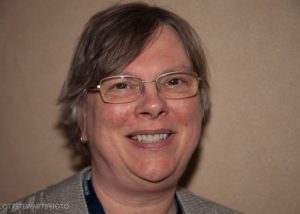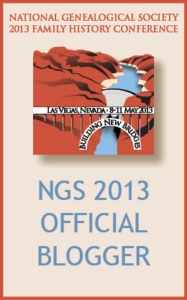
© 2013 by the National Genealogical Society, Inc.
Used by permission of the National Genealogical Society
and the photographer, Scott Stewart.
Please welcome guest blogger ____, CGSM
No, that welcome message is not a mistake. I put out two email calls to Board-certified genealogists requesting guest bloggers. Instantly many people stepped forward and scooped up speeches by Tom Jones, Judy Russell, and Elizabeth Shown Mills. My own presentation waited and waited ... {{shaking head in embarrassment}}.
It's not quite fair for me to review my presentation. I'm not unbiased, am I? I thought about putting a third frantic request out to the Board-certified associates, but then I decided to blog about what it is like to give a speech at a big genealogy conference. It seemed a better route to take than to risk a third rejection.
The process began more than a year earlier, when I answered the Call for Proposals from NGS. I used the "console" to enter the required data, from my contact information, biography, and experience as a speaker to the title, an outline, and a brief description of the speech itself. I then waited until I was contacted by the Program Chair several months later. I had to sign a contract. I also decided to approve having the sessions recorded by JAMB-Inc.
There were two more milestones. About three months before the conference, I had to send in my handout/syllabus material. I made sure to format it as required to fit properly in the syllabus, and to email a pdf version. That gave me time to polish my speeches using PowerPoint software.
The final milestone was to show up and deliver the speeches. This meant packing my own projector and computer, including lugging them through airport security and stuffing them into storage bins on the packed airplane. I made my own flight booking, but NGS booked two room nights for me. I extended that booking to include the full conference. I invested in flight costs and five nights at the hotel. The trip meant adding on other costs, such as parking in Boston, taxis to and from the Las Vegas hotel, and meals. On the plus side, my convention registration was gratis and I got a check for both speeches. In total, I will have to spend more money that I take in, but the overall conference costs are reduced because my speeches were accepted for the program.
Butterflies in my stomach? Totally. I used the nervous energy to go over the PowerPoint slides and to reread the speeches -- as well as to arrive in plenty of time for each speech. I set up my projector, set up my computer, and used the convention center's built-in cabling to connect them. The Las Vegas Hotel Convention Center supplied an A/V specialist who checked in with me before each speech to ensure that all was in working order. In addition, JAMB-Inc sent a man to double-check the recording device and put in a fresh CD. Once I got the thumbs-up from him, I was free to begin.
The errors speech needed tuning up the week of the convention. I wanted to make sure that the discussion of sources, information, and evidence was in parallel with a newly published book on genealogical proof.[1] There were about 50 or 60 people there to hear the lecture. They took notes earnestly, so I felt that the revision effort was well worth it. Once it was over, I packed as quickly as I could so that the next presenter could set up.
My speech on recognizing errors is meant for those beginning to work with the terminology used for sources, information, and evidence. I went over the various terms carefully, explaining what each meant and how it is useful to document analysis and evidence evaluation.
This session has been taped. During the conference you can buy it from the JAMB-INC booth in the main conference hall. After the conference, it will be available online at http://www.jamb-inc.com/category/genealogy. This is session S441 under the heading 2013 NGS Conference/Las Vegas, NV.

[1] Thomas W. Jones, Mastering Genealogical Proof (Arlington, Va.: National Genealogical Society, 2013). It can be ordered online http://www.ngsgenealogy.org/cs/mastering_genealogical_proof from the National Genealogical Society. It is a workbook. You read a chapter on a topic and then work on the questions at the end of the chapter. The topics I discussed are in Chapter 2.